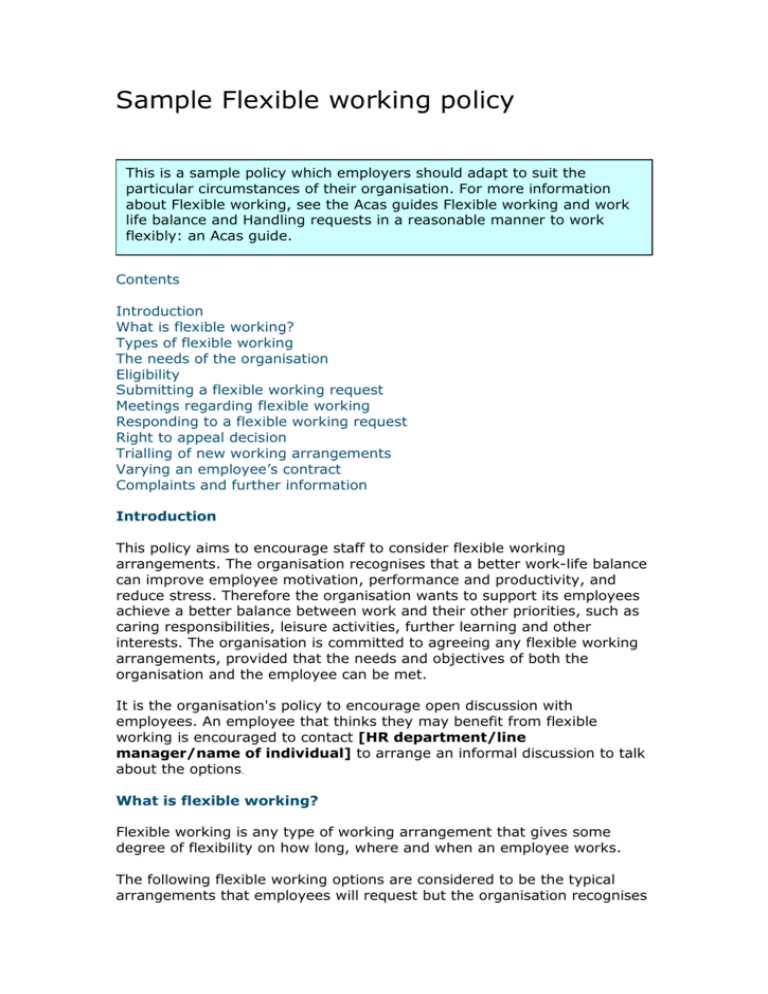Flexible working hours letter template

To request flexible working hours, start by clearly stating the need for adjustment. Be direct and specify the desired change, such as working from home, adjusting start or end times, or compressing hours. Provide context, if necessary, about how the new schedule would enhance productivity or accommodate personal commitments.
State your current work arrangement and highlight how the requested change aligns with your job responsibilities. Mention how it can improve work-life balance without affecting your job performance. This ensures your request feels balanced and reasonable.
Keep the tone polite and professional, and express your willingness to collaborate on finding a solution. If you’re open to a trial period or periodic review, mention that to show flexibility. This approach demonstrates that you’re committed to your role while adapting to changing needs.
Here are the revised lines:
Adjust working hours: Clearly specify the agreed flexible working hours. For instance, instead of “flexible,” state exact start and end times, or range of acceptable hours, to avoid ambiguity.
Communication of availability: Specify how employees should inform the team about their working hours, whether through an app, email, or another tool, to ensure clarity and prevent misunderstandings.
Adjustments to schedule: Outline a process for how changes to the flexible hours can be made, and ensure that the process is fair and transparent for everyone involved.
Time tracking: Define how employees will track their hours, whether it’s manually or through a software tool, to keep things simple and organized.
Clarify expectations: Make it clear that flexibility should not hinder productivity. Set clear guidelines for performance expectations during the flexible hours.
Feedback process: Mention how feedback will be gathered from employees about the flexible hours arrangement to make any necessary adjustments down the line.
- Flexible Working Hours Letter Template
To request flexible working hours, begin with a clear and polite tone. Address the recipient respectfully and express your need for flexibility in your work schedule. Be specific about the changes you are seeking and provide a reason for the request. For example, you might need to adjust your hours due to family commitments, health reasons, or personal development needs.
Here’s a template you can use:
Dear [Manager’s Name],
I hope this message finds you well. I am writing to request an adjustment to my working hours. Due to [briefly explain the reason], I would like to explore the possibility of adjusting my schedule from [current hours] to [desired hours]. This change would help me manage my responsibilities more effectively.
I’m open to discussing how this can be implemented smoothly and ensuring that it does not affect the team’s workflow. I believe this adjustment will allow me to remain productive and meet all work requirements.
I look forward to hearing your thoughts and discussing how we can proceed with this request. Thank you for your understanding.
Best regards,
[Your Name]
Key Considerations:
- Provide a clear explanation for your request.
- Show flexibility in discussing the details with your manager.
- Ensure that your request aligns with company policies and team needs.
When receiving a request for flexible working hours, consider the specific needs of the employee while maintaining the operational requirements of the business. Review how the change would impact the team and whether the request aligns with company policies. Acknowledge the importance of balancing productivity and employee satisfaction.
Assessing the Request

Evaluate the nature of the job. Some positions may allow for flexibility in working hours, while others may require set schedules. Look at how the proposed change would affect deadlines, team collaboration, and overall workflow. In cases where flexibility is viable, establish clear guidelines for how and when the change will take effect.
Setting Expectations
Communicate expectations clearly with the employee. Define specific working hours, deadlines, and availability for meetings. Be transparent about the trial period or evaluation process to ensure the arrangement benefits both the employee and the company.
Clearly state your desired working hours in the first sentence. Be specific about the changes you are requesting, such as the number of hours or a shift in start and end times. Avoid vague language.
Provide Justification
Explain the reasons behind your request. Highlight how flexible hours will improve your productivity, work-life balance, or overall job satisfaction. Ensure your rationale aligns with the company’s goals, focusing on mutual benefit.
Propose a Trial Period
Suggest a trial period to assess how the flexible hours will work in practice. This shows your willingness to be adaptable and allows your manager to evaluate the impact without committing to a permanent change right away.
Conclude with an offer to discuss the arrangement further. Be open to feedback and show that you’re willing to collaborate to find a solution that works for both you and the company.
Employers must first assess whether flexible working hours align with company goals. It’s crucial to evaluate the impact on productivity, team dynamics, and client service. Consider offering flexibility based on job roles–some positions may require set hours, while others can function well with adjusted schedules.
Clear Communication and Expectations
Set clear boundaries for flexible working arrangements. Establish guidelines on availability, communication, and performance expectations. This ensures that employees understand their responsibilities, even with flexible schedules. Provide tools that support seamless communication, such as project management software or regular check-ins, to keep everyone on track.
Review Impact on Team Collaboration
Flexible hours can sometimes hinder collaboration if team members work at different times. Regularly assess how changes affect collaboration and morale. Encourage virtual meetings or collaboration platforms to maintain engagement and keep team cohesion intact. Flexibility should not compromise teamwork and company culture.
Flexible work arrangements can offer substantial benefits to both employers and employees, but they come with legal obligations that must be clearly understood. Employers should ensure that work hours and expectations are specified in contracts to avoid potential disputes. Failure to do so could lead to complications regarding overtime, wage calculations, or disagreements about employee availability.
It’s critical for companies to comply with labor laws governing working hours, rest periods, and breaks. In some jurisdictions, even flexible arrangements must adhere to minimum wage laws, overtime pay, and the maximum number of hours employees can work in a given period. For example, if an employee works beyond the legal limit, additional compensation or time off may be required.
Employers should also address remote work conditions in legal agreements, including data privacy, security measures, and the handling of confidential information. If employees are granted the flexibility to work from home or other locations, it’s essential to ensure that business operations are not compromised by location-based challenges.
Finally, clear communication about expectations is crucial. Employers need to define flexible work schedules in writing to avoid misunderstandings related to performance, attendance, or job responsibilities. This transparency can help prevent legal issues regarding workplace discipline or employee rights.
Flexible working hours templates help create clear guidelines for adjusting schedules while ensuring productivity. Below are a few examples that can be easily customized for different needs.
Example 1: Standard Flexible Hours Request
This template is for employees requesting to change their work schedule. It allows for adjusting daily start and end times.
- Subject: Request for Flexible Work Hours
- Dear [Manager’s Name],
- I would like to request a shift in my working hours. I propose to begin work at [Proposed Start Time] and end at [Proposed End Time], with a [Length of Break] break each day. This change will allow me to better manage my [Reason for Request], while ensuring my responsibilities are met. Please let me know if this adjustment is possible or if there are any concerns.
- Best regards, [Your Name]
Example 2: Temporary Flexible Schedule for Personal Reasons
This example works well for situations where employees need a temporary change to their work schedule, such as for a personal matter.
- Subject: Temporary Flexible Hours Request
- Dear [Manager’s Name],
- I am writing to request temporary changes to my working hours from [Start Date] to [End Date] due to [Reason]. I propose working from [Proposed Start Time] to [Proposed End Time] for the duration of this period. I assure you that I will meet all work expectations and deadlines. Your consideration of this request is much appreciated.
- Sincerely, [Your Name]
Example 3: Permanent Flexible Work Hours Proposal
This template is for proposing a permanent shift in working hours to better accommodate personal or professional needs.
- Subject: Proposal for Permanent Flexible Working Hours
- Dear [Manager’s Name],
- After careful consideration, I would like to request a permanent change to my working hours. I propose to work from [Proposed Start Time] to [Proposed End Time], with a break of [Break Duration]. This adjustment will improve my work-life balance and ensure consistent output. I am happy to discuss any further details and accommodate the company’s needs during this transition.
- Thank you for your time and understanding.
- Best regards, [Your Name]
Be specific about your request. Vague descriptions can cause confusion and delay. Clearly state the hours you prefer, the reason behind your request, and any flexibility you are offering. This helps your manager understand your needs right away.
- Missing deadlines for requests: Make sure to submit your work hours request well in advance, giving your supervisor enough time to consider and respond.
- Not providing enough detail: Simply stating you want flexible hours may not be sufficient. Be clear about why you need them and how you plan to manage your workload.
- Failing to consider team impact: Avoid making requests that disrupt the team’s schedule or workflow. Think about how your change might affect colleagues or ongoing projects.
- Not being open to negotiation: Be ready to adjust your request. Flexibility should go both ways, so show a willingness to compromise if your initial proposal doesn’t work.
- Not following company policy: Ensure your request aligns with your company’s guidelines for flexible hours. Ignoring these can lead to unnecessary complications.
By avoiding these mistakes, you ensure that your request is clear, reasonable, and easier for management to process. Being proactive and thorough can help you secure the arrangement that works best for both you and your employer.
Set clear expectations for flexible working hours. Establish specific time frames for availability, ensuring that employees know when they are expected to be online or available for meetings.
Clearly outline any flexibility in daily start and end times. For example, allow employees to choose their hours between 7:00 AM and 9:00 AM for a flexible start, but require them to work until 3:00 PM at the latest.
Avoid ambiguity in your communication. Specify whether breaks are flexible or if they must be taken within a certain window. Clearly define how to request time off for personal matters or appointments.
Example of Flexible Working Hours Agreement:
| Aspect | Details |
|---|---|
| Start Time | Between 7:00 AM and 9:00 AM |
| End Time | Between 3:00 PM and 5:00 PM |
| Core Hours | 10:00 AM – 2:00 PM (mandatory availability) |
| Break Time | Flexible, but must be taken between 12:00 PM and 2:00 PM |
| Requesting Time Off | Notify at least 24 hours in advance |